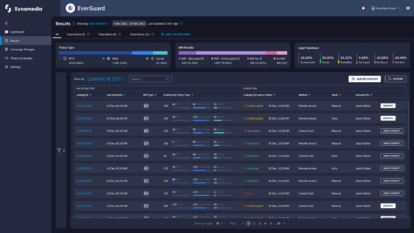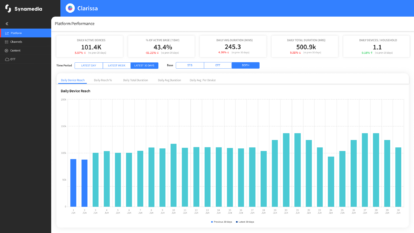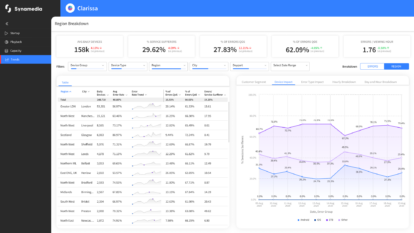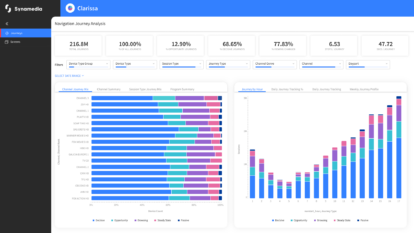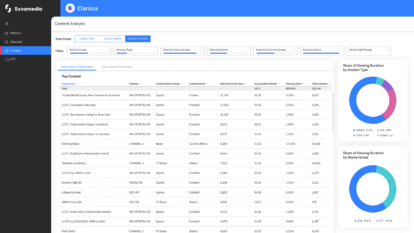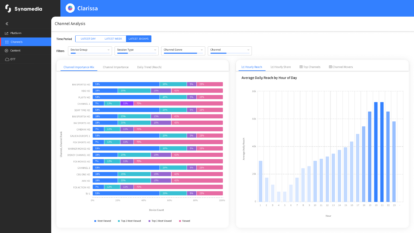Every Friday night is pizza and movie night at my house. We pick up our favourite New York-style cheese pizza and settle down in front of the TV to find something to stream. But with two adults, a teenager, and a pre-teen in the room, it can be hard to find a show or movie that fits everyone’s tastes. We spend 15 minutes or more going in and out of apps, up and down video-on-demand (VOD) catalogues, using search, watching trailers, checking parental ratings, and arguing… all while our pizza goes cold.
And we’re not alone. As viewers use more and more streaming services and content rights migrate from one service to another, finding the right show, event, or movie can be challenging.
In this article, we explore how you can transform your data into application insights, to find the best pathways that viewers use to discover video content and make the user experience (UX) more contextual, efficient, and personalised.
What is streaming content discovery?
Streaming content discovery refers to the process by which viewers search, browse, and find content on streaming platforms. The process typically involves various tools and algorithms which work to make the process more user-friendly and reduce the effort required to find relevant content. Features such as personalised recommendations or trending categories are often included on these platforms to make the streaming content discovery process more engaging and navigable for the user.
Why is streaming content discovery important?
It improves the user experience
One of the pull factors of streaming platforms is their extensive media library. However, the vast amount of content available can make it difficult to find certain content, with 72% of streaming consumers becoming frustrated when trying to find something to watch.
An effective streaming content discovery process will allow users to easily navigate these vast libraries to find content that suits their preferences and interests. One way in which the streaming content discovery process can be made user-friendly is through the use of personalised recommendations whereby a series of related shows are displayed based on viewing habits.
It can enhance customer retention
As an impact of an improved user experience, an effective content discovery process can enhance customer retention. Through continually making recommendations based on previous behaviour, viewers are more likely to explore the content and are subsequently less likely to cancel their subscription.
Research has shown that households who only watch one show on a streaming platform have a higher likelihood of cancelling their subscription than those who explored a range of content.
How streaming insights can improve streaming content discovery
Insights into user behaviour and device capabilities play a pivotal role in enhancing the streaming content discovery process. Here are three ways in which providers can use insights to improve streaming content discovery.
Data can contextualise the streaming content discovery process
Data can be used to gain insights into how the streaming content discovery process varies by device, type of viewer, and time of day.
Every device used to access content has different capabilities that can significantly impact the process of streaming content discovery. For instance, features such as touchscreens or voice input on a streaming device can lead to unique patterns of feature usage compared to traditional broadcast devices.
Additionally, the type of streaming content viewers are looking for can also impact the streaming content discovery process. Viewers looking for news and sports content, for instance, tend to exhibit a different set of behaviours compared to those seeking dramas or documentaries.
Lastly, timing is another important factor in the promotion and positioning of video content. Leveraging insights into seasonal patterns can help providers identify the best times of the day, week, or year to strategically highlight events such as the Olympics, the Oscars, and other timely topics within the user experience to enhance the content discovery process.
Data can streamline streaming content discovery
Video streaming insights provide a comprehensive overview of user behaviour that can be used to optimise the user experience. Through tracking content discovery journeys you can identify opportunities to streamline interactions to reduce the number of steps and time required for users to discover and engage with content.
Success in this context, does not just relate to how quick the streaming content discovery process is, rather it can also be measured through engagement statistics, such as viewing duration. Understanding feature adoption and usage patterns through app insights not only works to prioritise product investment but can also improve the platform’s user experience.
Data can personalise and localise content discovery
The way each of us interacts with TV is different, and while it may not be possible to deliver a completely unique experience for every viewer, there is value in tailoring the user experience for certain segments. For instance, addressing children’s unique content discovery preferences and usage patterns with a more tailored UX can enhance their experience.
Additionally, in certain regions, especially multi-ethnic and multilingual regions, there may be discernible patterns that warrant unique streaming content discovery approaches. Leveraging data-driven content grouping can play a big role in targeting content. UX concepts such as ‘Most Popular Now’ or ‘Trending in Your Area’ can bring a local flavour to content recommendations that reflect community trends.
Get video content discovery right with Synamedia
Keeping viewers engaged in your video service means helping them find compelling content quickly, so they spend less time searching and more time watching.
Synamedia Clarissa turns your data into application insights on what is and isn’t working in your user experience. It can also uncover viewing patterns that you can leverage for a more personalised approach, and make sure that the content and features are relevant to the situation in which they are being used.
Using data insights to get video content discovery right can help your service stand apart from the crowd and make sure your content gets the attention it deserves. Help your customers find what they want to watch quickly and with less arguing. The pizza will probably taste better too!
Explore Synamedia Clarissa today.
About the Author
Ben is a 20+ year veteran of the video industry, having worked in various roles including pre-sales, applications engineering, and technical marketing for Scientific-Atlanta, Cisco, and now Synamedia. He is currently the Product Marketing lead for the Synamedia Iris and Clarissa solutions. Ben holds a BS and master’s degree in Electrical Engineering from the Georgia Institute of Technology. In his spare time, Ben enjoys watching football, playing guitar, and nerding out over Marvel movies and Terry Pratchett novels.

